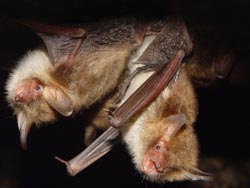Caught in the act: Bats use the sound of copulating flies as a cue for foraging

Natterer's bat (Myotis nattereri)<br>Image: Stefan Greif<br>
Stefan Greif from the Max Planck Institute for Ornithology, and colleagues, observed this in a long-term study on wild Natterer’s bats that eat the copulating flies in a double-sized meal. Flies that were just sitting or walking on the ceiling did not elicit a predatory response by the bats. This is the first experimental evidence how mating itself can be risky.
Mating activities are a dangerous business because the attention to other important events in the surroundings is often reduced. Therefore the duration of copulation itself is usually very short. About 100 years ago researchers argued that copulating animals are at a higher risk of being discovered and, consequently, being eaten by a predator. Yet, surprisingly, there are only few observations that support this hypothesis. These examples comprise studies in water-living insects, such as amphipods and water striders, and also in land insects, as investigated in a recent study in Australian plague locusts that are at a higher risk of being eaten as mating pairs compared to single animals.
Apart from decreased attention, a reduced flight response as well as an enhanced conspicuousness induces a higher risk for these winged lovers to be easy prey. Stefan Greif from the Max Planck Institute for Ornithology, and colleagues, have now provided experimental proof for this phenomenon. In a community of house flies and Natterer’s bats in a cowshed near Marburg, Germany, they analysed videotapes of the movements of almost 9000 flies. The researchers found that the flies rarely fly at night and mostly sit or run on the ceiling. Finding the flies by echolocation is nearly impossible for the bats as the faint insect echo is completely masked by the strong background echo which makes them virtually “invisible”.
This scenario completely changes when the male flies find a suitable mating partner. The subsequent copulation is a noisy event because males then produce broadband buzzing sounds that can be heard by the bats. Around five per cent of the fly pairs that engage in copulation were attacked and mostly eaten by the bats (across four observation years, even 26 per cent of the observed copulating pairs were attacked).
In order to provide evidence that it is really the sound that makes the flies detectable for the bats, the researchers mounted dead, noiseless fly pairs on the shed ceiling in a position they usually take during copulation. These exhibits provide a larger reflection area for echolocation of the bats compared to a single fly. However, they were never attacked by the bats. Only when the researchers played back the copulation sounds of the flies, did the bats try to attack the loudspeakers. Accordingly Stefan Greif summarizes the results of the study in a simplistic way: “sex kills”.
Original work:
Björn M. Siemers, Eva Kriner, Ingrid Kaipf, Matthias Simon and Stefan Greif
Bats eavesdrop on the sound of copulating flies.
Current Biology, published online on June, 23, 2012.
Contact:
Stefan Greif
Max Planck Research Group “Sensory Ecology“
Max Planck Institute for Ornithology, Seewiesen
Phone: +49 8157 932 376
Email: greif@orn.mpg.de
Dr. Sabine Spehn
Public Relations
Max Planck Institute for Ornithology, Seewiesen
Phone: +49 8157 932 421
Email: pr_seewiesen@orn.mpg.de
Media Contact
More Information:
http://www.orn.mpg.deAll latest news from the category: Life Sciences and Chemistry
Articles and reports from the Life Sciences and chemistry area deal with applied and basic research into modern biology, chemistry and human medicine.
Valuable information can be found on a range of life sciences fields including bacteriology, biochemistry, bionics, bioinformatics, biophysics, biotechnology, genetics, geobotany, human biology, marine biology, microbiology, molecular biology, cellular biology, zoology, bioinorganic chemistry, microchemistry and environmental chemistry.
Newest articles

High-energy-density aqueous battery based on halogen multi-electron transfer
Traditional non-aqueous lithium-ion batteries have a high energy density, but their safety is compromised due to the flammable organic electrolytes they utilize. Aqueous batteries use water as the solvent for…

First-ever combined heart pump and pig kidney transplant
…gives new hope to patient with terminal illness. Surgeons at NYU Langone Health performed the first-ever combined mechanical heart pump and gene-edited pig kidney transplant surgery in a 54-year-old woman…

Biophysics: Testing how well biomarkers work
LMU researchers have developed a method to determine how reliably target proteins can be labeled using super-resolution fluorescence microscopy. Modern microscopy techniques make it possible to examine the inner workings…





















